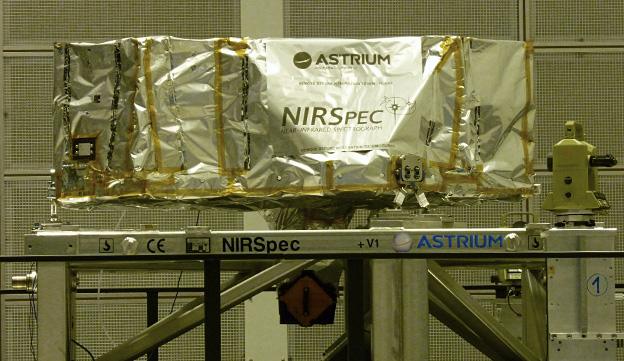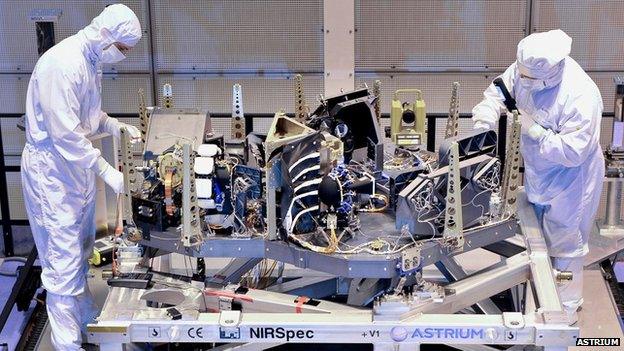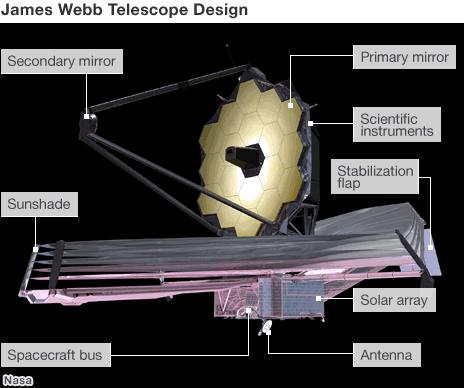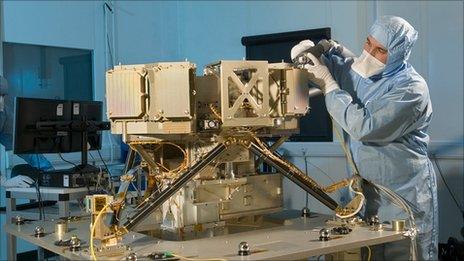James Webb telescope: 'First starlight' instrument complete
- Published

Europe has reached another milestone in its contribution to Hubble's successor - the James Webb Space Telescope.
An industrial team led from Astrium in Germany has completed the build of the Near-Infrared spectrometer, one of four instruments that will go in JWST.
NirSpec's job will be to determine the age, composition, movement and distance of the objects in its field of view.
The expectation is that some of these targets will include the very first stars to shine in the Universe.
That would mean picking up light signals that have travelled across space for perhaps 13.6 billion light-years - something Hubble cannot do.
JWST will make it possible with a suite of next-generation technologies, external, including a 6.5m primary mirror (more than double the width of Hubble's main mirror), and a shield the size of a tennis court to guard its keen vision against the light and heat from the Sun.
NirSpec is critical to this new capability, and represents 10 years of design and manufacturing endeavour.
Prof Mark McCaughrean: NirSpec is an important milestone for Europe
In a short ceremony in Ottobrunn on Friday, the instrument was handed over to the European Space Agency (Esa), which had commissioned NirSpec. The Paris-based organisation then immediately passed the near-200m-euro instrument to the US space agency (Nasa), which leads the JWST venture.
On 20 September, NirSpec will be flown to Maryland's Goddard Space Flight Center for integration into the giant orbiting observatory.
Europe's major industrial commitments to JWST are now complete.
Its other instrument - the Mid-Infrared Instrument (Miri), which was assembled in the UK - was safely delivered to North America last year.
Ralf Maurer: The instrument makes great use of silicon carbide
The one outstanding task - and it is a very onerous one - will be to launch JWST in October 2018. This will be performed by an Ariane 5 rocket from Esa's Kourou spaceport in French Guiana.
When I visited NirSpec in the Ottobrunn clean room last week, there was not much to see because the finished instrument was dressed for shipment in its protective thermal coat.
But if you could lift that covering, you would lay eyes on what appears to be an impossible optical maze.
NirSpec will be mounted just behind JWST's primary mirror and will sample the gathered light via a kind of periscope.
A series of mini-mirrors will then corral and condition this light, moving it towards a grating element where it can be sliced and diced into its component colours - its spectra. Detectors are positioned at the end of the maze to read these colours and convert them into an electronic signal that can be transmitted to the ground.
All this is done in the near-infrared, in the wavelengths from 0.6 to 5 microns. This is the region of the electromagnetic spectrum where you would expect to pick up starlight that has been stretched on its 13-billion-year journey across an expanding cosmos.
An interesting aspect of NirSpec's design is that nearly half by weight of the instrument is made from ultra-stiff silicon carbide.
"The unique feature of silicon carbide is that it allows us to make structure and mirrors out of the same material," explains Astrium programme manager Ralf Maurer.
"This helps us survive the transition going from warm to cold; there is no deformation. And that gives us a very stable alignment of the optics."

And without the cover: Nearly half by weight is made out of silicon carbide
Seeing in the infra-red allows you to probe not just distant objects, but also cool objects and targets obscured by the light-scattering effects of dust. And so JWST should make many important discoveries in the close-by Universe, the most exciting of which may come in the study of planets around other stars. For some of these worlds, James Webb will have the power to discern the chemical compositions of their atmospheres, which should tell us a lot about the prevailing conditions at their surfaces.

James Webb is being assembled at Nasa's Goddard Space Flight Center
Of course, it is very difficult to have a discussion about JWST without some reference to the problems it has encountered during its build. A mix of funding, technical, and management shortcomings have resulted in years of delay and a ballooning full and final cost (now expected to be close to $10bn if European and Canadian contributions are included).
Indeed, NirSpec leaves Germany with two US-provided components that do not meet the required specifications, and which will have to be exchanged before launch.
These are the instrument's infrared detectors and its system of microshutters.
The performance of the detectors has degraded over time and will now be replaced by a modified design that is in the process of being manufactured.
The microshutter array uses 250,000 tiny gates to select objects on the sky for study - up to 100 at a time. Some of the gates were getting stuck in an open position during testing. Goddard's experts have come up with a solution that, again, is well advanced.
Whilst it is right that JWST should account for its mistakes, it is worth remembering also that Hubble's full life-cycle costs are probably double that projected for the new telescope, even after the overruns.

NirSpec uses a system of tiny gates to select the objects for study
It is easy to forget that Hubble's mission has required six extremely expensive shuttle launches. For sure, the old observatory has had a major impact on modern science, but many of those I speak to expect nothing less from JWST.
"Webb will be transformative, in the way that Hubble was before it," argues Nasa's Dr Eric Smith, the acting programme director for the observatory project.
"When Hubble was first conceived it had a set of science requirements and more-or-less predicted discoveries it could make; and indeed, it made all of those. But the most wondrous things that Hubble has found are the things that weren't predicted. Webb will have things just like that," he told me.
And Prof Mark McCaughrean, from the European Space Agency, puts it slightly differently: "There is no question at all that JWST is a central part of the next decade's exploration of the Universe. Many other observatories have been planned around the knowledge of JWST being there, and taking complementary data. It advances in sensitivity not by factors of 10, not even by factors of a hundred in many places, but by factors of a thousand or ten thousand. It's a telescope whose time has come."

James Webb's main mirror has around seven times more collecting area than Hubble's 2.4m primary mirror
The sunshield is about 22m by 12m. There will be a 300-degree difference in temperature between the two sides
James Webb's instruments must be very cold to ensure their own infrared glow does not swamp the observations
The mission will launch in 2018 on an Ariane rocket. The observing position will be 1.5 million km from Earth
- Published23 August 2011

- Published18 August 2011

- Published7 July 2011
- Published11 November 2010